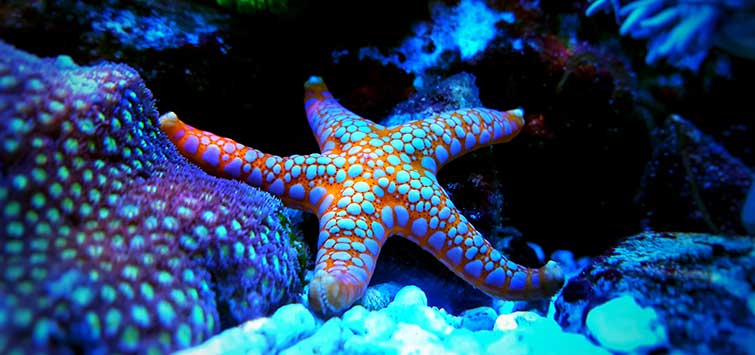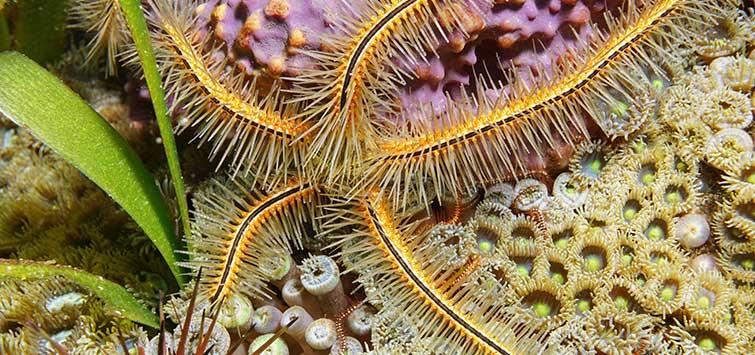Marbled or Tile Sea Stars
Author: Bob Fenner
Starfish are generally considered difficult to keep in a reef aquarium, but those of the genus Fromia may just be an exception to the rule.
A 5-Star Animal
Marine aquarists often find echinoderms to be contradictions. On one hand, they’re known to be tough to the point of being able to regenerate limbs (or even whole bodies from just a limb), but on the other, they often die mysteriously from lethargy and erosion, or they just silently dissolve away when we try to keep them in captivity.
As in all groups of organisms, there is a variation in the relative hardiness and aquarium suitability within the sea stars, with some having dismal records in terms of incidental mortality (e.g., the members of the genus Linckia) and some being much better (though still not very good) for captive use. Of the tougher genera that make their way into commercial availability, my all-time favorites are the smaller species of the genus Fromia. They are small in size (about 6 inches maximum), gorgeous in coloration, and not too difficult for reef aquarists to feed. Note, however, that they are suitable only for advanced reefkeepers.
Species
Of the eleven or so Fromia species, I’ve seen five for sale from time to time: F. elegans; F. ghardaqana, a red sea endemic; F. milleporella, a reddish star from eastern Africa to the South Pacific featuring pores visible on the upper surface and a flat appearance without tubercles; F. monilis, the necklace sea star, found in shallow waters in rocky habitats; and—also from such habitats—F. nodosa, the knobby fromia, from the Indo-West Pacific.
Not Much Behavior
These invertebrates are not very energetic. They are quite sedentary, occasionally crawling over other sedentary invertebrates. The only reason to be alarmed is if a star doesn’t move at all day to day or frequents the surface, as these are sure signs that something is amiss in your system chemically or physically.
Be aware that these stars sometimes release bubbles or white and brownish matter from their leg tips and disks. These normal exudations should not be accidentally mistaken for evidence of necrosis.
Selection
As with most all starfish species, one can’t tell much just by looking at a Fromia star: They look fine, whether they are healthy or soon to be dead. You should leave newly arrived specimens at your dealer to harden and rest up for a week or more before taking them home. Be on the lookout for the usual indications of trouble with spiny-skinned animals: a total lack of movement, whitish or otherwise discolored patches on the body, and any outright depressions that are discharging fluid from the body. Seeing any of these should discourage a purchase.
Though almost all topics in reefkeeping cause differences of opinion, I’ve yet to hear anyone suggesting anything other than a very slow acclimation process for introducing new sea stars. An hour or more of slow drip is best, and if there is more than a 0.001 difference in specific gravity or any discernible difference in pH between the old system’s water and your own, it’s a very good idea to let the new specimens make the transition over several days’ time in a separate isolation system. Add water from the main tank on a daily basis to gradually bring the parameters in synch.
Better Stars
One of the unfortunate realities of the aquarium hobby is that many commonly available animals are not really suited for aquarium life. In the marine hobby are many species sold on the basis of their appearance, despite the fact that they almost never survive more than a few months in the home aquarium. There are fish and invertebrates that are sold so widely that people figure they must be good specimens to purchase.
Many sea stars, or starfish, are in this group. Unusual in shape and behavior, starfish are often brightly colored as well. Unfortunately many of these invertebrates are doomed to waste away when people take them home. The stars in the genus Fromia are a pleasant exception. While they’re still not for beginners or for most community tanks, reefkeepers can enjoy these invertebrates, whose needs are easily met in a typical reef tank.
Setup
Marbled sea stars are poster children for reef-safeness. They generally leave other life alone and in turn are usually left alone, except by the usual suspects—crabs, larger hermits, puffers, and triggers.
The aquarium for Fromia sea stars (and for the vast majority of marine invertebrates, actually) should be well established; a running time of six months or more would be a good minimum amount of time to wait before their introduction. This is not only to allow time for the water parameters to stabilize, but also so the system has time to culture food organisms useful to the starfish. The tank should also have excellent water quality, of course.
There is likewise a positive correlation with the size/volume of the systems and success in keeping echinoderms. The larger the better, with a good deal of healthy live rock helping even more. Fromias require a system of a minimum of 100 gallons. Furthermore, in keeping with the notion of providing optimized, stable water chemistry, all top-off and water-change water should be pre-mixed, stored, and matched to the chemical and physical parameters of the water in the tank. Supplements or additions of any kind should be diluted and added very slowly.
Feeding
Fromia species are for the most part detritivores, mostly feeding on minute animals (microfauna) found in and among detritus. In captivity they benefit from occasional offerings of meaty foods (shrimp, krill, mussel, clam, etc.) cut up in small sizes and emulsified in a gel, or something similar in the way of a commercially made wafer, placed near them.
Proceed with Caution
Most sea stars survive less than a month in captivity. This high mortality is due principally to the trade/hobbyist selecting improper specimens (e.g., Linckia spp.) and harsh collection, holding, and shipping techniques. It is also due to a lack of proper environment and husbandry on the part of hobbyists. The genus Fromia is exemplary in being much more sturdy on average, and beautiful to boot! However, even these animals require established reef conditions.
See the full article on TFH Digital http://www.tfhdigital.com/tfh/201004/#pg99

.png?h=595&iar=0&w=2781&hash=5FD5E69473BCC22199FBFA2FB71B6033)



